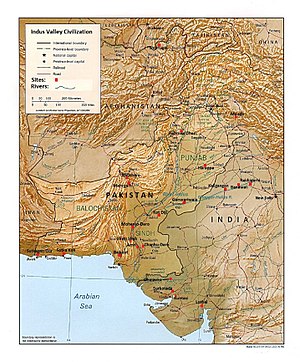The Indus Valley Civilisation (IVC) was a Bronze Age civilisation (3300–1300 BCE; mature period 2600–1900 BCE) mainly in the northwestern regions of South Asia, extending from what today is northeast Afghanistan to Pakistan and northwest India. Along with ancient Egypt and Mesopotamia it was one of three early civilisations of the Old World, and of the three, the most widespread. It flourished in the basins of the Indus River, which flows through the length of Pakistan, and along a system of perennial, mostly monsoon-fed rivers that once coursed in the vicinity of the seasonal Ghaggar-Hakra river in northwest India and eastern Pakistan. Aridification of this region during the 3rd millennium BCE may have been the initial spur for the urbanisation associated with the civilisation, but eventually also reduced the water supply enough to cause the civilisation's demise, and to scatter its population eastward. At its peak, the Indus Civilisation may have had a population of more than five million people. Inhabitants of the ancient Indus river valley developed new techniques in handicraft (carnelian products, seal carving) and metallurgy (copper, bronze, lead, and tin). The Indus cities are noted for their urban planning, baked brick houses, elaborate drainage systems, water supply systems, and clusters of large non-residential buildings. The Indus Valley Civilisation is also known as the Harappan Civilisation, after Harappa, the first of its sites to be excavated in the 1920s, in what was then the Punjab province of British India, and now is Pakistan. The discovery of Harappa, and soon afterwards, Mohenjo-Daro, was the culmination of work beginning in 1861 with the founding of the Archaeological Survey of India in the British Raj. Excavation of Harappan sites has been ongoing since 1920, with important breakthroughs occurring as recently as 1999. There were earlier and later cultures, often called Early Harappan and Late Harappan, in the same area of the Harappan Civilisation. The Harappan civilisation is sometimes called the Mature Harappan culture to distinguish it from these cultures. As of 1999, more than 1,056 cities and settlements had been found, of which 96 have been excavated, mainly in the general region of the Indus and Ghaggar-Hakra Rivers and their tributaries. Among the settlements were the major urban centres of Harappa, Mohenjo-daro (UNESCO World Heritage Site), Ganeriwala in modern-day Pakistan; and Dholavira and Rakhigarhi in present-day India. The Harappan language is not directly attested and its affiliation is uncertain because the Indus script is still undeciphered. A relationship with the Dravidian or Elamo-Dravidian language family is favoured by a section of scholars.




Comment
0